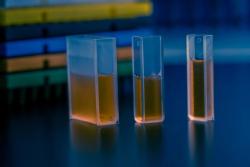
OR WAIT null SECS
- About Us
- Advertise
- Contact Us
- Editorial Info
- Editorial Advisory Board
- Do Not Sell My Personal Information
- Privacy Policy
- Terms and Conditions
© 2025 MJH Life Sciences™ , Pharmaceutical Technology - Pharma News and Development Insights. All rights reserved.
Coding and marking technologies for the pharmaceutical industry
Pharmaceutical Technology Europe
The right choice [of coding and marking technology] depends upon the company's top priorities regarding legibility, cost, speed, ease of use, cleanliness and security.
Worldwide pharmaceutical packaging demand is anticipated to reach an annual growth rate of 5.3% making the world pharmaceutical packaging industry worth $24.3 billion in 2009.1 More than 80% of revenues will be absorbed by the 10 largest drug-producing countries.
Growth of the pharmaceutical packaging industry is expected to follow upward trends in global medication consumption, which will expand at a strong pace as aging demographic patterns lead to an increasing number of diseases and disorders. Furthermore, the adoption of stricter regulations and standards governing the production, storage, distribution and labelling of pharmaceuticals will boost global growth opportunities for packaging products and accessories.
Historically, pharmaceutical packaging requirements focused exclusively on preserving the quality of the enclosed medication and increasing the products' shelf lives. These requirements are now being extended to cover such criteria as the prevention of product tampering and counterfeiting, the assurance of product dispensing accuracy, child protection and the promotion of patient compliance with product dosage schedules.
Pharmaceutical noncompliance is a tremendous problem in the US, resulting in an estimated $100 billion expense every year while being blamed for the deaths of over 125000 Americans annually (342 people every day). Ten percent of all hospital admissions are the result of pharmaceutical noncompliance and 23% of all nursing home admissions are as a result of people's inability to take their medications as prescribed.2
In February 2004, FDA published the final version of 21 CFR Parts 201, 606 and 610 to reduce the number of medication errors in hospitals and healthcare settings. The rule specifies that the packaging of all human drugs be labelled with a linear bar code containing the National Drug Code (NDC) number that serves as a universal product identifier. This 10-digit code identifies the labeller/vendor, product, trade package size, the specific strength, the dosage and the formula for a specific firm.
According to the Healthcare Compliance Packaging Council (HCPC), the National Quality Forum (NQF) and FDA, the implementation of unit dose blister and strip packaging places a further restraint on the intentional or accidental misuse of pharmaceuticals. Furthermore, the EU specifies that all prescription drugs dispensed directly to patients be in a unit dose packaging. FDA describes unit dose packaging as the only packaging format that can accommodate bar codes on packaging labels for each dosage of medication dispensed to patients.3
Coding and marking technologies for the primary packaging of pharmaceuticals must constantly evolve to meet the emerging industry trends and associated regulations. Bar coding methods have been traditionally chosen according to three main criteria:
- the kind of data required to appear on the bar code (numeric symbols, alpha-numeric or special characters).
- the amount of available space on which to print and the specific location of the bar code.
- Where the bar code needs to be placed near an edge, there is a considerable risk of misreads (when a scanner cannot read the bar code).
There is a wide variety of printers available for coding and marking pharmaceutical primary packaging including thermal transfer, inkjet, dot-matrix, laser, flexographic and colour change. It is not easy for companies to choose the appropriate technology that would suit their specific needs. The right choice depends upon the company's top priorities regarding legibility, cost, speed, ease-of-use, cleanliness and security.
Thermal transfer and inkjet printers. These are more appropriate for production line bar code printing. Specifically, thermal transfer printers produce high quality, legible and clear bar codes, as well as other types of codes. Because ink is not involved, there is never any quality degradation during the process. Moreover, such printers are virtually maintenance free while they can also be connected to a software network for record-keeping purposes, which helps with validation. The main drawback of this technology is that although it can be set up quickly, it lacks printing speed.
Inkjet printers. These are the fastest and least expensive units available on the market. Unfortunately, there are considerable limitations to what they can print. In addition, they require frequent maintenance and can be quite messy. Another major downfall is that the print fades after successive use. Water-based inkjet fluids tend to streak and blur, while nonwater, soluble inkjet fluids produce a shine that reflects to the scanner and affects how the bar code is read.
Dot-matrix printers. These printers produce low-quality codes with low contrast, although this depends on the ribbon used.
Laser printers. These are off-line devices requiring a separate label applicator. A further disadvantage is that they are subject to toner flaking, meaning that they are unreliable for long-term bar code printing.
Laser marking by ablation. This more recent method uses a high powered beam to ablate the bar code onto the label by burning away a black ink patch to form the white spaces by exposing the underlying substrate material. However, this method results in high emission levels and can also create problems for bar code resolution levels.
Flexographic printers. These produce high-quality images, thereby being most suitable for printing small characters but they can be costly to use and maintain because a plate change is required for every coding change.
Colour change technology. This is a noncontact, high resolution, low emission technique that generates high definition data, bar codes and graphics to an infinite array of materials. Combining chemistry, substrate conversion and laser energy, this process uses very low power laser light for the high speed, on-demand printing of variable information on primary packaging. The subsequent laser imaging process provides a means of marking without ablation and it does not require any ink or ribbons. Additionally, the technology is virtually maintenance free, non-toxic and environmentally friendly.
Colour change technology is equally suitable for any type of primary packaging substrate including flexible packaging, paper, board and plastics. The technology's versatility makes it ideal for a wide range of applications relating to coding, marking, and tracking and tracing. Because of the stability of the image produced, this solution provides extreme protection for brand integrity.
Conclusion
In summary, scientists working in the pharmaceutical packaging industry should base their choice of printing technology on three main criteria — first, the regulations governing pharmaceutical practice, second, their company's specific coding and marking needs, and third, the benefits and downfalls each particular method involves.
Andrew Jackson is applications marketing manager, DataLase (formerly Sherwood Technology), UK.
References
1. http://freedonia.ecnext.com/coms2/summary_0285-307433_ITM



